Fix Windows Modules Installer Worker High CPU Usage
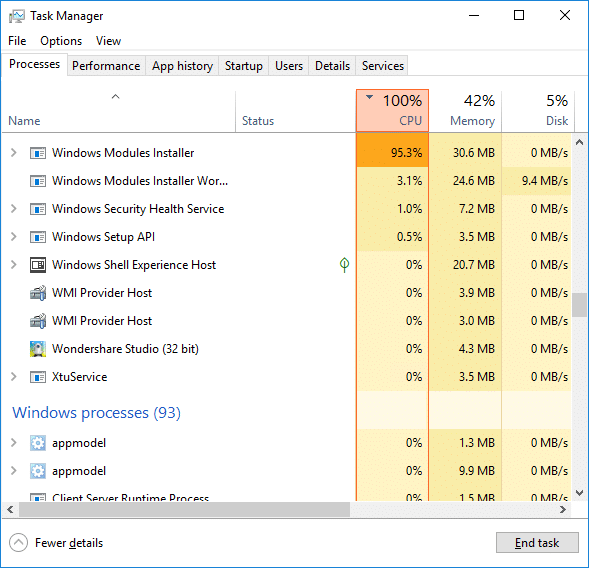
If you are facing the High CPU Usage by Windows Modules Installer Worker, then don’t worry as thousands of other users are also facing the similar problem and therefore, there are many working fixes which we will be discussing today in this article. To verify if you are facing this issue open Task Manager (Ctrl + Shift + Esc) and you will find that the Windows Modules Installer Worker is consuming High CPU or Disk Usage.

ಪ್ರೊ ಸಲಹೆ: You may leave your PC overnight or for a few hours to see the issue rectify itself once the Windows is finished downloading and installing updates.
What is Windows Modules Installer worker (WMIW)?
Windows Modules Installer worker (WMIW) is a service which takes cares of automatically installing Windows Update. According to its service description, WMIW is a system process that enables automatic installation, modification, and removal of Windows updates and optional components.
This process is responsible for finding new Windows Update automatically and installing them. As you might be aware that Windows 10 automatically install newer builds (i.e. 1803 etc.) via Windows Updates, so this process is responsible for installing these updates in the background.
Although this process is called Windows Modules Installer worker (WMIW) and you will see the same name in the Processes tab in the Task Manager, but if you switch to Details tab, then you will find the name of the file as TiWorker.exe.
Why Is Windows Modules Installer worker Using So Much CPU?
As Windows Modules Installer worker (TiWorker.exe) runs continuously in the background, sometimes it might utilize high CPU or disk usage when installing or uninstalling Windows Updates. But if its constantly using high CPU then the Windows Modules Installer worker may have become unresponsive while checking new updates. As a result, you may be experiencing lags, or your system might hang or freeze completely.
The first thing users do when they experience freezing, or lagging issues on their system is to restart their PC, but I assure you that this strategy won’t work in this case. This is because the issue will not resolve by itself until and unless you fix the underlying cause.
Fix Windows Modules Installer Worker High CPU Usage
ಏನಾದರೂ ತಪ್ಪಾದಲ್ಲಿ ಮರುಸ್ಥಾಪನೆ ಬಿಂದುವನ್ನು ರಚಿಸಲು ಖಚಿತಪಡಿಸಿಕೊಳ್ಳಿ.
Windows Modules Installer Worker (WMIW) is an important service, and it should not be disabled. WMIW or TiWorker.exe is not a virus or malware, and you cannot just delete this service from your PC. So without wasting any time let’s see How to Fix Windows Modules Installer Worker High CPU Usage ಕೆಳಗೆ ಪಟ್ಟಿ ಮಾಡಲಾದ ದೋಷನಿವಾರಣೆ ಮಾರ್ಗದರ್ಶಿಯ ಸಹಾಯದಿಂದ.
ವಿಧಾನ 1: ವಿಂಡೋಸ್ ಅಪ್ಡೇಟ್ ಟ್ರಬಲ್ಶೂಟರ್ ಅನ್ನು ರನ್ ಮಾಡಿ
1. ತೆರೆಯಲು ವಿಂಡೋಸ್ ಕೀ + I ಒತ್ತಿರಿ ಸೆಟ್ಟಿಂಗ್ಗಳು ನಂತರ ಕ್ಲಿಕ್ ಮಾಡಿ ನವೀಕರಣ ಮತ್ತು ಭದ್ರತೆ ಐಕಾನ್.
![]()
2. ಎಡಗೈ ಮೆನುವಿನಿಂದ, ಆಯ್ಕೆಮಾಡಿ ನಿವಾರಣೆ ಅಡಿಯಲ್ಲಿ "ಎದ್ದೇಳಲು ಮತ್ತು ಓಡುವುದು” ಕ್ಲಿಕ್ ಮಾಡಿ ವಿಂಡೋಸ್ ಅಪ್ಡೇಟ್.

3. ಈಗ “ಕ್ಲಿಕ್ ಮಾಡಿಟ್ರಬಲ್ಶೂಟರ್ ಅನ್ನು ರನ್ ಮಾಡಿ"ವಿಂಡೋಸ್ ಅಪ್ಡೇಟ್ ಅಡಿಯಲ್ಲಿ.
4. Let the troubleshooter run, and it will automatically fix any issues found with Windows Update taking forever.
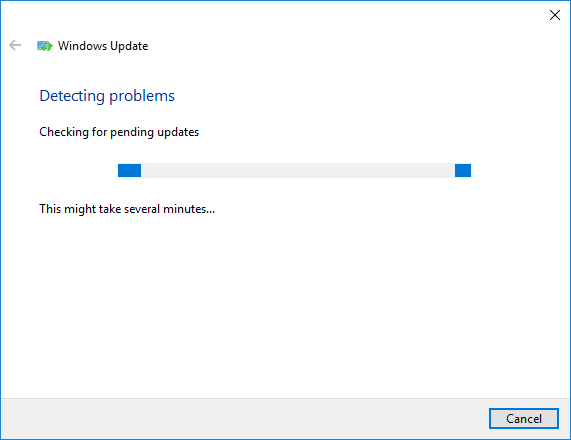
Method 2: Manually Check for Windows Updates
1. ವಿಂಡೋಸ್ ಕೀ + I ಅನ್ನು ಒತ್ತಿ ನಂತರ ಆಯ್ಕೆಮಾಡಿ ನವೀಕರಿಸಿ ಮತ್ತು ಭದ್ರತೆ.
2. ಎಡಭಾಗದಿಂದ, ಮೆನು ಕ್ಲಿಕ್ ಮಾಡುತ್ತದೆ ವಿಂಡೋಸ್ ಅಪ್ಡೇಟ್.
3. ಈಗ " ಮೇಲೆ ಕ್ಲಿಕ್ ಮಾಡಿನವೀಕರಣಗಳಿಗಾಗಿ ಪರಿಶೀಲಿಸಿಲಭ್ಯವಿರುವ ಯಾವುದೇ ನವೀಕರಣಗಳಿಗಾಗಿ ಪರಿಶೀಲಿಸಲು ” ಬಟನ್.

4. ಯಾವುದೇ ನವೀಕರಣಗಳು ಬಾಕಿಯಿದ್ದರೆ, ನಂತರ ಕ್ಲಿಕ್ ಮಾಡಿ ನವೀಕರಣಗಳನ್ನು ಡೌನ್ಲೋಡ್ ಮಾಡಿ ಮತ್ತು ಸ್ಥಾಪಿಸಿ.

5. ನವೀಕರಣಗಳನ್ನು ಡೌನ್ಲೋಡ್ ಮಾಡಿದ ನಂತರ, ಅವುಗಳನ್ನು ಸ್ಥಾಪಿಸಿ ಮತ್ತು ನಿಮ್ಮ ವಿಂಡೋಸ್ ನವೀಕೃತವಾಗುತ್ತದೆ.
Method 3: Configure Windows Update to Manual
ಎಚ್ಚರಿಕೆ: This method will switch Windows Update from automatically installing the new updates to the manual. This means you have to manually check for Windows Update (weekly or monthly) to keep your PC secure. But follow this method, and you can again set the Updates to Automatic once the issue is resolved.
1. ವಿಂಡೋಸ್ ಕೀ + ಆರ್ ಒತ್ತಿ ನಂತರ ಟೈಪ್ ಮಾಡಿ services.msc ಮತ್ತು Enter ಅನ್ನು ಒತ್ತಿರಿ.

2. Scroll down and find ವಿಂಡೋಸ್ ಮಾಡ್ಯೂಲ್ಗಳ ಸ್ಥಾಪಕ service in the list.
3. ಬಲ ಕ್ಲಿಕ್ ಮಾಡಿ Windows Modules Installer service ಮತ್ತು ಆಯ್ಕೆ ಮಾಡಿ ಪ್ರಾಪರ್ಟೀಸ್.
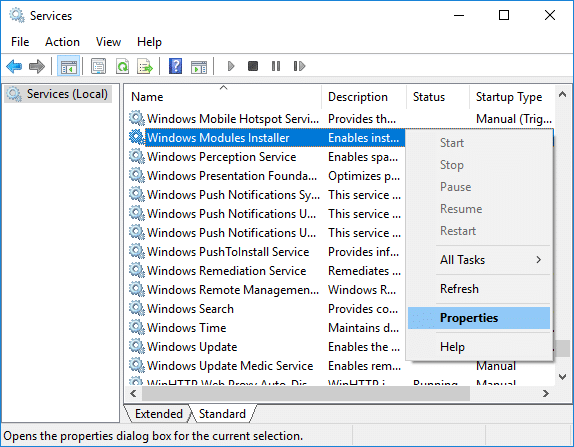
4. ಈಗ ಕ್ಲಿಕ್ ಮಾಡಿ ನಿಲ್ಲಿಸು then from the ಆರಂಭಿಕ ಮಾದರಿ drop-down select ಕೈಪಿಡಿ.
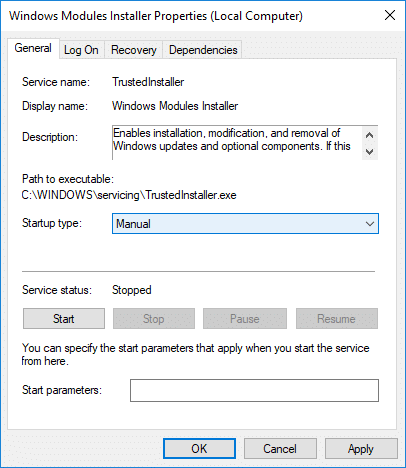
5. ಅನ್ವಯಿಸು ಕ್ಲಿಕ್ ಮಾಡಿ, ನಂತರ ಸರಿ.
6. Similarly, follow the same step for the Windows Update service.

7. ಬದಲಾವಣೆಗಳನ್ನು ಉಳಿಸಲು ನಿಮ್ಮ ಪಿಸಿಯನ್ನು ರೀಬೂಟ್ ಮಾಡಿ.
8. ಮತ್ತೆ ಪರಿಶೀಲಿಸಿ Windows Updates Manually ಮತ್ತು ಯಾವುದೇ ಬಾಕಿ ಇರುವ ನವೀಕರಣಗಳನ್ನು ಸ್ಥಾಪಿಸಿ.
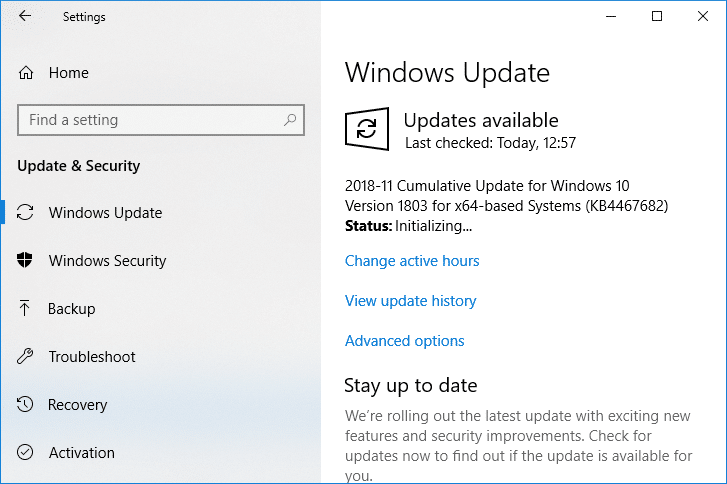
9. Once is done, again go back to services.msc window and open the Windows Modules Installer & Windows Update Properties ವಿಂಡೋ.
10. ಹೊಂದಿಸಿ ಆರಂಭಿಕ ಮಾದರಿ ಗೆ ಸ್ವಯಂಚಾಲಿತ ಮತ್ತು ಕ್ಲಿಕ್ ಮಾಡಿ ಪ್ರಾರಂಭಿಸಿ. Then click Apply followed by OK.
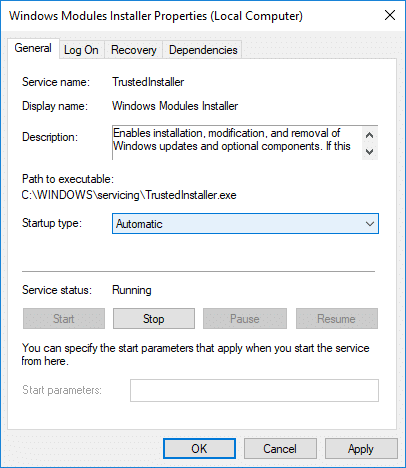
11. ಬದಲಾವಣೆಗಳನ್ನು ಉಳಿಸಲು ನಿಮ್ಮ ಪಿಸಿಯನ್ನು ರೀಬೂಟ್ ಮಾಡಿ.
ವಿಧಾನ 4: ಸಿಸ್ಟಮ್ ನಿರ್ವಹಣೆ ಟ್ರಬಲ್ಶೂಟರ್ ಅನ್ನು ರನ್ ಮಾಡಿ
1. ವಿಂಡೋಸ್ ಕೀ + ಆರ್ ಒತ್ತಿ ನಂತರ ಕಂಟ್ರೋಲ್ ಟೈಪ್ ಮಾಡಿ ಮತ್ತು ತೆರೆಯಲು ಎಂಟರ್ ಒತ್ತಿರಿ ನಿಯಂತ್ರಣಫಲಕ.

2. ದೋಷನಿವಾರಣೆಯನ್ನು ಹುಡುಕಿ ಮತ್ತು ಕ್ಲಿಕ್ ಮಾಡಿ ನಿವಾರಣೆ.

3. ಮುಂದೆ, ಕ್ಲಿಕ್ ಮಾಡಿ ಎಲ್ಲ ವೀಕ್ಷಿಸಿ ಎಡ ಫಲಕದಲ್ಲಿ.
4. ಕ್ಲಿಕ್ ಮಾಡಿ “System Maintenance” ಚಲಾಯಿಸಲು System Maintenance Troubleshooter.

5. ಟ್ರಬಲ್ಶೂಟರ್ಗೆ ಸಾಧ್ಯವಾಗಬಹುದು Fix Windows Modules Installer Worker High CPU Usage, but if it didn’t, then you need to run System Performance Troubleshooter.
6. ಕಮಾಂಡ್ ಪ್ರಾಂಪ್ಟ್ ತೆರೆಯಿರಿ. ಹುಡುಕುವ ಮೂಲಕ ಬಳಕೆದಾರರು ಈ ಹಂತವನ್ನು ನಿರ್ವಹಿಸಬಹುದು 'cmd' ತದನಂತರ Enter ಅನ್ನು ಒತ್ತಿರಿ.

7. ಕೆಳಗಿನ ಆಜ್ಞೆಯನ್ನು cmd ಗೆ ಟೈಪ್ ಮಾಡಿ ಮತ್ತು Enter ಒತ್ತಿರಿ:
msdt.exe / ಐಡಿ ಕಾರ್ಯಕ್ಷಮತೆ ಡಿಗ್ನಾಸ್ಟಿಕ್
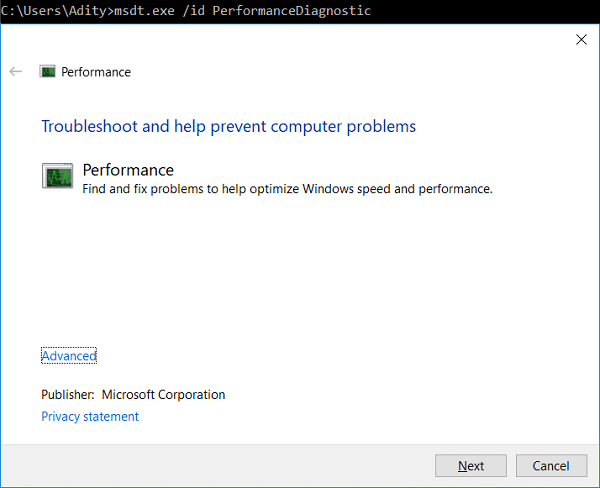
8. Follow the on-screen instruction to run the troubleshooter and fix any issues find the System.
9. Finally, exit the cmd and reboot your PC.
Method 5: Disable Automatic Maintenance
Sometimes Automatic Maintenance can conflict with the Windows Modules Installer Worker service, so try to disable Automatic Maintenance using this guide and see if this fixes your issue.
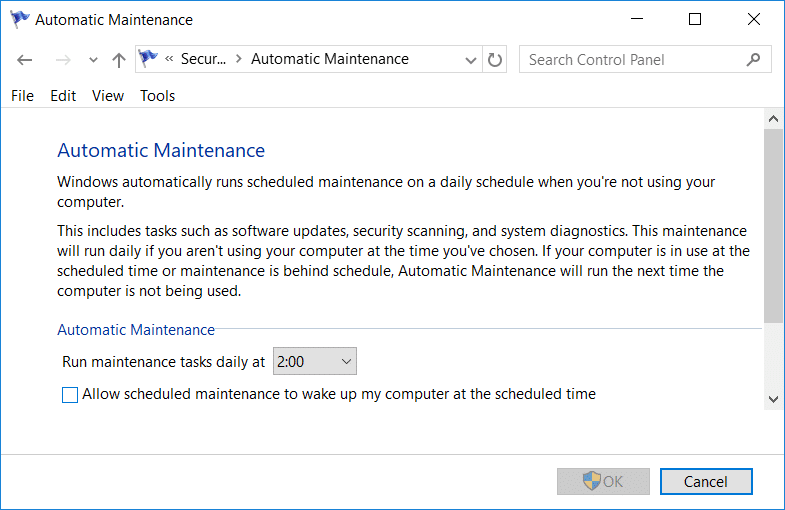
Although disabling Automatic Maintenance is not a good idea, but there might be some case where you need to actually disable it, for example, if your PC freezes during automatic maintenance or Windows Modules Installer Worker High CPU Usage issue then you should disable maintenance to troubleshoot the issue.
Method 6: Run System File Checker and ಡಿಎಸ್ಎಮ್
1. ಕಮಾಂಡ್ ಪ್ರಾಂಪ್ಟ್ ತೆರೆಯಿರಿ. ಹುಡುಕುವ ಮೂಲಕ ಬಳಕೆದಾರರು ಈ ಹಂತವನ್ನು ನಿರ್ವಹಿಸಬಹುದು 'cmd' ತದನಂತರ Enter ಅನ್ನು ಒತ್ತಿರಿ.
2.ಈಗ cmd ನಲ್ಲಿ ಈ ಕೆಳಗಿನವುಗಳನ್ನು ಟೈಪ್ ಮಾಡಿ ಮತ್ತು ಎಂಟರ್ ಒತ್ತಿರಿ:
Sfc / scannow sfc / scannow /offbootdir = c: /offwindir = c:windows (ಮೇಲೆ ವಿಫಲವಾದರೆ ಇದನ್ನು ಪ್ರಯತ್ನಿಸಿ)

3. ಮೇಲಿನ ಪ್ರಕ್ರಿಯೆಯು ಮುಗಿಯುವವರೆಗೆ ನಿರೀಕ್ಷಿಸಿ ಮತ್ತು ಒಮ್ಮೆ ಮಾಡಿದ ನಂತರ, ನಿಮ್ಮ ಪಿಸಿಯನ್ನು ಮರುಪ್ರಾರಂಭಿಸಿ.
4. ಮತ್ತೆ cmd ತೆರೆಯಿರಿ ಮತ್ತು ಕೆಳಗಿನ ಆಜ್ಞೆಯನ್ನು ಟೈಪ್ ಮಾಡಿ ಮತ್ತು ಪ್ರತಿಯೊಂದರ ನಂತರ ಎಂಟರ್ ಒತ್ತಿರಿ:
ಡಿಸ್ಮ್ / ಆನ್ಲೈನ್ / ಕ್ಲೀನಪ್-ಇಮೇಜ್ / ಚೆಕ್ ಹೆಲ್ತ್ ಡಿಸ್ಮ್ / ಆನ್ಲೈನ್ / ಕ್ಲೀನಪ್-ಇಮೇಜ್ / ಸ್ಕ್ಯಾನ್ ಹೆಲ್ತ್ ಡಿಸ್ಮ್ / ಆನ್ಲೈನ್ / ಕ್ಲೀನಪ್-ಇಮೇಜ್ / ರಿಸ್ಟೋರ್ ಹೆಲ್ತ್

5. DISM ಆಜ್ಞೆಯು ರನ್ ಆಗಲಿ ಮತ್ತು ಅದು ಮುಗಿಯುವವರೆಗೆ ಕಾಯಿರಿ.
6. ಮೇಲಿನ ಆಜ್ಞೆಯು ಕಾರ್ಯನಿರ್ವಹಿಸದಿದ್ದರೆ, ಕೆಳಗಿನದನ್ನು ಪ್ರಯತ್ನಿಸಿ:
ಡಿಸ್ಮ್ / ಇಮೇಜ್: ಸಿ: ಆಫ್ಲೈನ್ / ಕ್ಲೀನಪ್-ಇಮೇಜ್ / ರಿಸ್ಟೋರ್ ಹೆಲ್ತ್ /ಸೋರ್ಸ್: ಸಿ:ಟೆಸ್ಟ್ಮೌಂಟ್ವಿಂಡೋಸ್ ಡಿಸ್ಮ್ /ಆನ್ಲೈನ್ /ಕ್ಲೀನಪ್-ಇಮೇಜ್ /ರಿಸ್ಟೋರ್ ಹೆಲ್ತ್ /ಸೋರ್ಸ್:ಸಿ:ಟೆಸ್ಟ್ಮೌಂಟ್ವಿಂಡೋಸ್ /ಲಿಮಿಟ್ಆಕ್ಸೆಸ್
ಸೂಚನೆ: C:RepairSourceWindows ಅನ್ನು ನಿಮ್ಮ ದುರಸ್ತಿ ಮೂಲದೊಂದಿಗೆ ಬದಲಾಯಿಸಿ (ವಿಂಡೋಸ್ ಇನ್ಸ್ಟಾಲೇಶನ್ ಅಥವಾ ರಿಕವರಿ ಡಿಸ್ಕ್).
7. ಬದಲಾವಣೆಗಳನ್ನು ಉಳಿಸಲು ನಿಮ್ಮ ಪಿಸಿಯನ್ನು ರೀಬೂಟ್ ಮಾಡಿ ಮತ್ತು ನಿಮಗೆ ಸಾಧ್ಯವೇ ಎಂದು ನೋಡಿ Fix Windows Modules Installer Worker High CPU Usage.
ವಿಧಾನ 7: ಕ್ಲೀನ್ ಬೂಟ್ ಮಾಡಿ
Sometimes 3rd party software can conflict with Windows and can cause the issue. To Fix Windows Modules Installer Worker High CPU Usage issue, you need to perform a clean boot on your PC and diagnose the issue step by step.
Method 8: Set your WiFi as Metered Connection
ಸೂಚನೆ: This will stop Windows Automatic Update, and you will need to manually check for Updates.
1. ತೆರೆಯಲು ವಿಂಡೋಸ್ ಕೀ + I ಒತ್ತಿರಿ ಸೆಟ್ಟಿಂಗ್ಗಳು ನಂತರ ಕ್ಲಿಕ್ ಮಾಡಿ ನೆಟ್ವರ್ಕ್ ಮತ್ತು ಇಂಟರ್ನೆಟ್.

2. ಎಡಗೈ ಮೆನುವಿನಿಂದ, ಆಯ್ಕೆಮಾಡಿ Wi-Fi.
3. Under Wi-Fi, ಕ್ಲಿಕ್ on your currently connected network (WiFi).
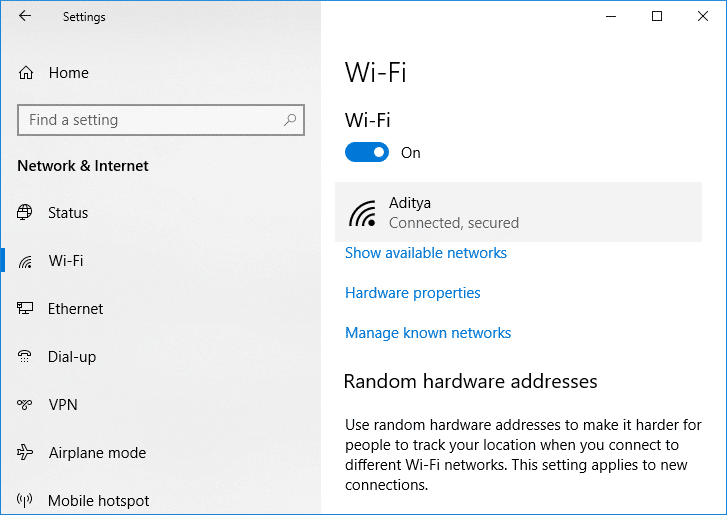
4. Scroll down to Metered connection and ಟಾಗಲ್ ಅನ್ನು ಸಕ್ರಿಯಗೊಳಿಸಿ ಅಡಿಯಲ್ಲಿ "ಮೀಟರ್ ಸಂಪರ್ಕವಾಗಿ ಹೊಂದಿಸಿ".
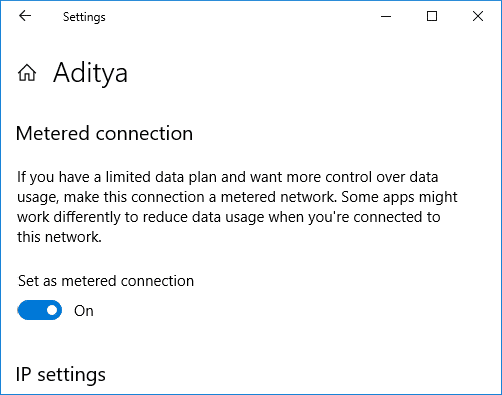
5. Close Settings and reboot your PC to save changes.
ಶಿಫಾರಸು:
ಅಷ್ಟೆ, ನೀವು ಯಶಸ್ವಿಯಾಗಿದ್ದೀರಿ Fix Windows Modules Installer Worker High CPU Usage ಆದರೆ ಈ ಟ್ಯುಟೋರಿಯಲ್ ಬಗ್ಗೆ ನೀವು ಇನ್ನೂ ಯಾವುದೇ ಪ್ರಶ್ನೆಗಳನ್ನು ಹೊಂದಿದ್ದರೆ ನಂತರ ಕಾಮೆಂಟ್ ವಿಭಾಗದಲ್ಲಿ ಅವರನ್ನು ಕೇಳಲು ಮುಕ್ತವಾಗಿರಿ.
